Following on from a Met Office decreed White Christmas in 2017, Edinburgh had a day of snow and then Storm Dylan blew through on the 31st. Fortuitously, the wind speed dropped for Edinburgh’s Hogmanay celebrations.
The full moon on the 2nd January lit up the darkness of the long nights and the cold wet start to the year; 24.8 mm of rain in the first seven days. This is just under our total for the whole of January 2017 of 25.6 mm.
A severe January frost blackened the Crinum collection in the sheltered east facing border usually given protection by the Orchid house. The snow in March then heaped more stress onto the, by now, rotting foliage. Nothing daunted, these bulbous South African plants would recover with the warmth of late spring to produce a succession of flowering spikes from May until December.
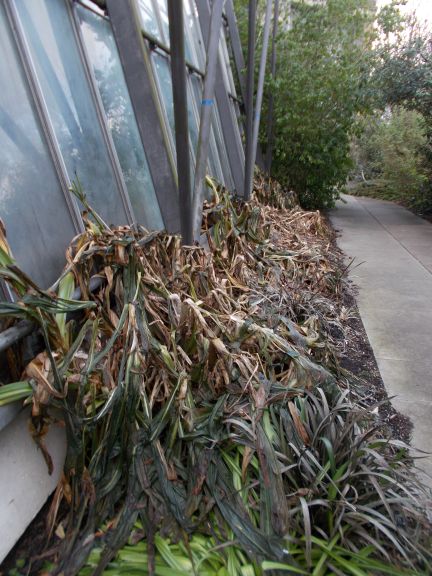
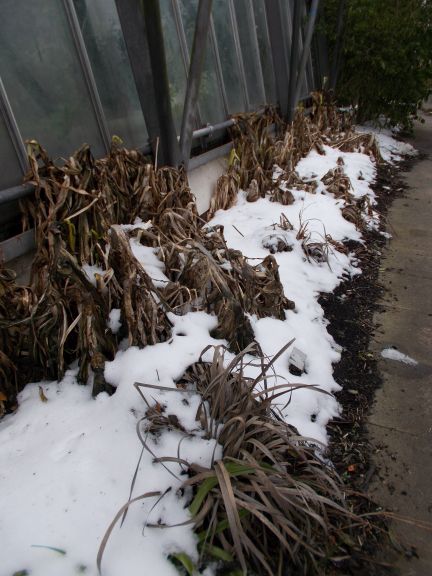
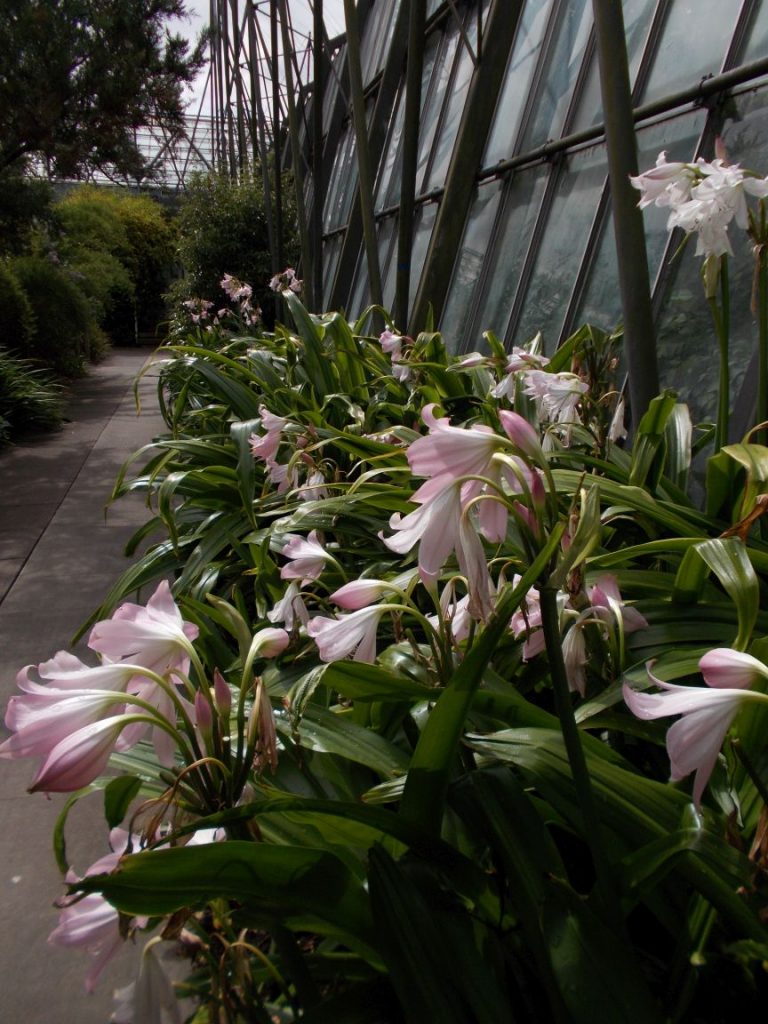
Snowstorms passed through Edinburgh like waves during January and into February. With them, below freezing temperatures that led to the embryo leaves that had broken free from the tight swollen buds of Rhubarb to be cut and damaged by the low temperatures. The age old practice of placing terracotta Rhubarb forcers or the more modest covering of straw and then an upturned metal dustbin over the clump, will protect from frost and guarantee quality pink stalks is to be recommended.
The scent from the Hamamelis and Sarcoccoca continued to fill the air, neither plant deterred by weather events. The four petalled white flowers on Vinca difformis appeared much smaller than in previous winters. In contrast, as the days lengthened, the pink perfumed cluster that comprise the floral inflorescence on Viburnum x bodnantense cultivars expanded to formidable size compared with those the plants produce through the winter months.
Despite the cold; market gardeners managed to send strawberries to the supermarket from the earliest ever ripened crop of UK fruit. A Welsh nursery sent fruit to a store in Bridgend on the 24th February. (Strawberries produced in Kincardineshire were available in the shops at the end of November 2018) This, in February days before Britain was hit by an intense cold (-9.5 °C at its lowest) and a snow laden weather front. The month of March saw depths of 300mm of dry powdery snow drift through the Garden and cause a red alert weather warning for Scotland’s central belt. The Horticultural team mobilised snow ploughs and dozens of snow scoops to clear the paths as the sky yielded blizzards of dry, powdery, drifting Siberian snow over the Garden. We could not however save the Snowdrops and other emerging spring bulbs from the deep carpet of snow. One of the prime weekends for Snowdrop walks cancelled with no way of recovering this time as it is cyclical and we can now only anticipate next year’s flowering. To prove these winter flowering bulbs were as used to snow cover as much as dappled sunshine through a deciduous tree canopy they recovered from the weight of a deep layer of snow burying them, to, if anything, continue with a vibrant look almost more intense than the lustre they had prior to the snow. What better way to celebrate our changing seasons and vagaries of weather than to plant a handful of bulbs somewhere in your garden. They provide a welcome to all.
Bright sunshine on the first day of spring, 20th March this year, followed a frosty night. The later flowering cultivar of Winter Aconite Eranthis hyemalis ‘Guinea Gold’ took full advantage of the sunrays and opened bright golden petals in appreciation of the warmth.
A wet, cold, miserable Easter weekend weather wise. The weather did open up for egg rolling families on Easter Sunday before turning wet again on the Monday. Ah, the trials and tribulations of being a gardener; the Easter weekend always holds so much promise, a long weekend to till soil and tidy borders, yet so weather dependant.
A day of heat in mid-April gave rise to much seed sowing in preparation for the growing season ahead.
The Edinburgh tradition of washing your face in the early morning dew on May Day was problematic due to the intense ground frost that set in through the night, soon disappearing with the heat of the sun. The blossom petals dropped to swirl across the ground in tsunami like waves. The intense dazzling rich red of the pendulous flowers lining the underside of the Ribes speciosum branches in the border at our office door was of a deeper intensity this year. Along with much of the woody flora where colour exhibited its full promise.
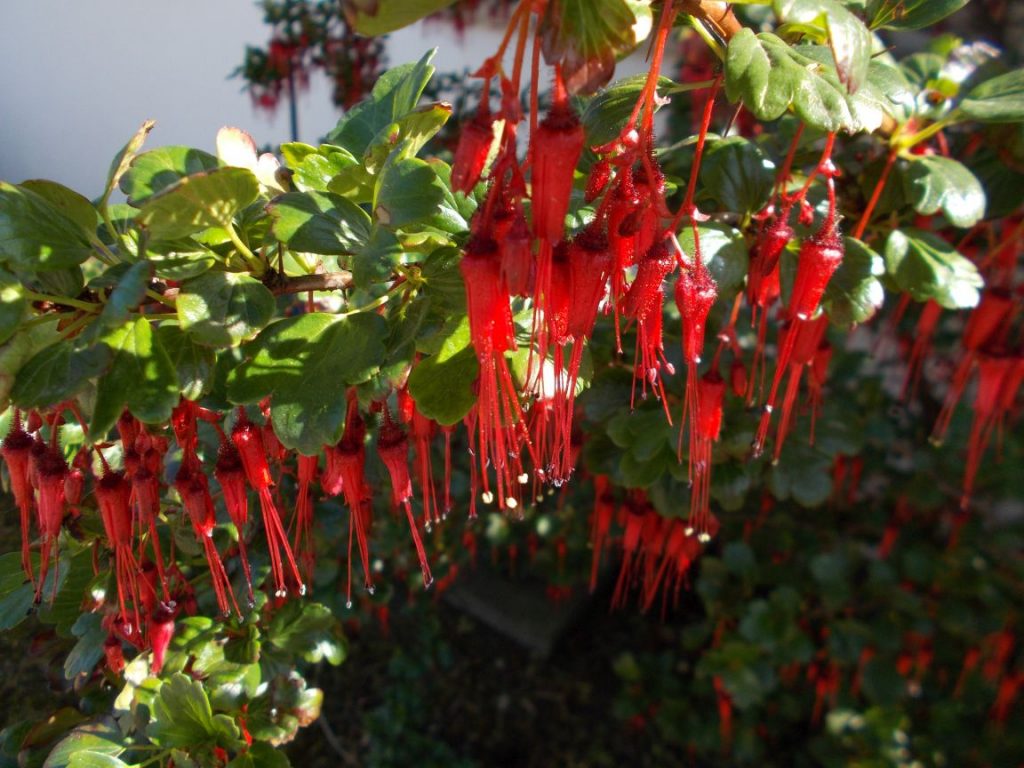
The bellwether guide confirming what a cold early season we had is the Wisteria on the south wall within the back yard. This venerable specimen flowered on the 9th May last year, yet 10 days later this year by 19th May the pendulous racemes were only just breaking colour.
May saw hot spells and was generally dry with the harr descending to almost smog like thickness around the late May holiday weekend. The spring flowering season was spectacular and a floral extravaganza. The sheer vanity of the flowers throughout May rewarded everyone who took a passing interest in the natural and cultivated world around them.
Laburnum was the star of the show this year, throughout Edinburgh the pendant racemes glowed yellow. The evergreen foliage of Embothrium which was desiccated as the “The Beast from the East” weather event enveloped the country at the end of February left me wondering if the Embothrium coccineum would recover. Yet recover they did and our east coast specimens produced clusters of vibrant orange flowers reminiscent of the legs of Daddy Long Legs every bit as good, if not surpassing this year, those growing in our west coast gardens.
Roughly speaking, May 2018 was drier and sunnier than the average May but with certain qualifications. The total rainfall was 16.6 mm and the sunshine total was 203.2 hours. The months of May in 2017 and 2016 were sunnier with 243.1 hours and 209.0 hours respectively but 2018 was drier. The long term averages for May are 52 mm of rain and 187 hours of sunshine. May 2018 had 23 dry days with 15 being consecutive.
The long term trend over the past 40 years shows a steady increase in total rainfall. Heavy rainfall events are becoming more frequent and intense, leading to more waterlogging, run-off and flooding.
With a third of the average rainfall this warm dry May helped produce the fieriest Radish I have ever grown.
Storm Hector brought all the settled weather to a close overnight of 13th June. Disruptive south westerly winds gusting to 50mph kept the Garden closed on the14th. On the 15th foliage already suffering from the low rainfall of May was desiccated, shredded and strewn around the Garden. The wide canopy of Mespilus germanica opposite the herbaceous border took the full brunt of the storm and uprooted. This exposed the dust dry soil profile and the rotting root system. The winds had also shredded the foliage of the pleached Lime hedge which resembled a caterpillar infested cabbage patch. Another casualty was the mature Cornus kousa in the winter garden. Again the west face of this multistemmed tree took the full force of the drying winds. Coupled by the fact that competition for soil moisture in this area is intense; the foliage was evaporating moisture faster than water could be translocate up through the woody structure from the roots. It was indeed an unfortunate time for a storm to blow through; almost mid-summer and at the height of the growing season.
These weather events illustrate how vulnerable plantings; those in the lee of buildings, in rain shadow areas, in competition with other mature plants of a deep rooting nature, are becoming. A night of rainfall will not make any noticeable difference to soil moisture levels in these areas. It may settle the dust but that is about all. Even several consecutive nights or days of rain will have little impact. We have a changing climate.
The rainfall total for June was 51.4mm, of this 34mm fell overnight of the 19th June, similar to the long term average of 59mm. These two months at the height of the growing season are when we need regular bursts of rainfall to maintain the soil moisture levels. A heavy downpour on already dry soil leads to run off and flooding. Not to a filling of the soil pores to benefit the roots of growing crops.
Even with the overnight downpour (34mm) in the second half of the month the grass in the lawns ceased to grow and browned in increasing and ever larger swathes. The heat had its advantages; Tropaeolum polyphyllum grew vigorously and cascaded down through the south facing mound in the rock garden shrouding itself in rich yellow flowers. The sight was spectacular. The New Zealand flora also did exceptionally well in the long hot summer; Hebe, Olearia, Prostanthera, Brachyglottis flowered prolifically through the summer months.
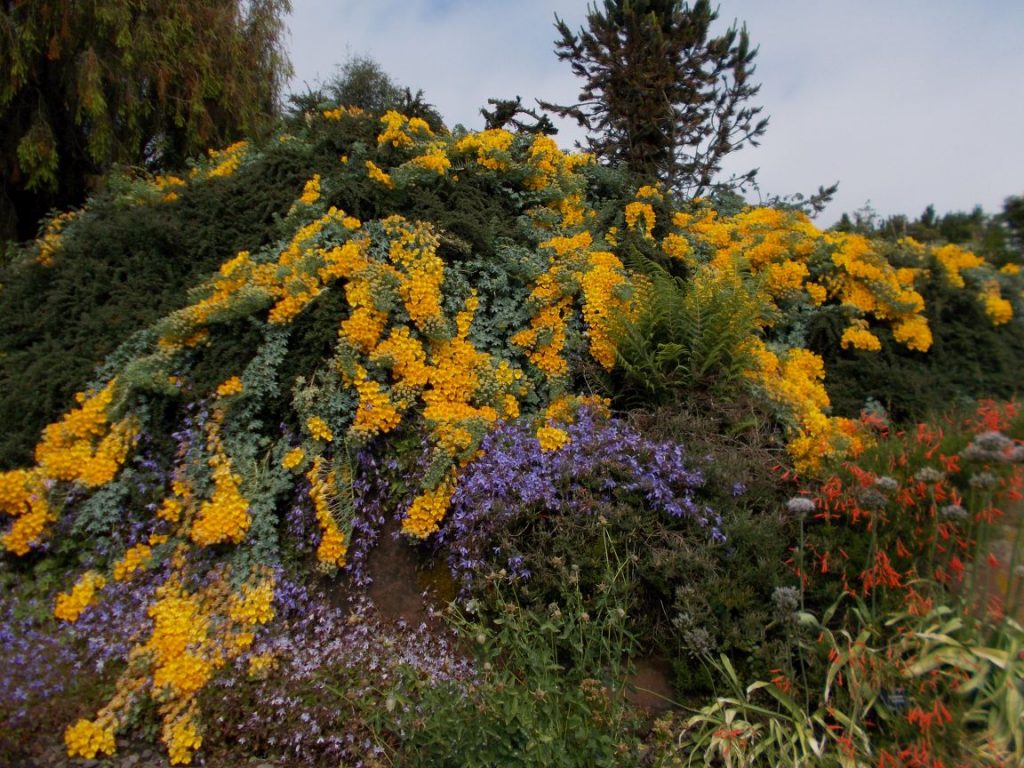
At the start of July Scottish Water advised using water wisely as consumption had risen with the continuing long dry spell. Temperatures during the month of July were consistently hovering around the mid 20°C. This then heated the soil with the 100mm deep soil thermometer reading 20°C on a couple of days. The combination of factors added up to soil moisture draining to negligible levels. Plants suffered with many woody plants exhibiting severe die back. Water butts were running on empty. With water rationed in some areas of the country should container culture be reviewed in the light of water shortages? The proliferation of Petunias, which were such a floral success this summer as annual bedding, relied on regular and sustained watering to keep the containers hydrated. Yet is this a justifiable use of our tap water? The time to consider a reduction in container gardening may be upon us.
On a positive note during the driest summer since 1976, the Roses bloomed to perfection. Tortoiseshell, Small and Large White Butterflies populated gardens, darting between and hovering over herbaceous plants in greater populations than I had noticed in previous years. Could you keep up with the prolific soft fruit production? Gooseberries, Raspberries, Strawberries, fresh from the garden and boiled for pies, cakes and jam. Very inventive culinary skills in the kitchen to make sure none went to waste.
An electric storm preceded two nights of rain on Thursday 26th July clearing the air and reducing the temperature. The rain continued to welcome the month of August refreshing the garden and reviving the lawns. Fortuitously our lawns did not reach the state of California brown that was seen throughout southern England. The recovering lawns were a perfect foil for the mop headed Hydrangeas that were doused in flower. All shades of pink, red to blue. Many outbreaks of powdery mildew on foliage and infestations of black aphids colonising flowering stems were spoiling the garden at this time.
The total rainfall for July 2018 was 32.8 mm and the sunshine total was 229.4 hours. By way of contrast in 2012 we had 181.6 mm of rain and 105 hours of sunshine. The averages for July are 62 mm of rain and 169 hours of sunshine.
In July we had four days when the temperature at 100mm below ground level reached and exceeded 20 degrees Celsius. These dates follow days or a run of consecutive days when the sunshine hours were in double figures. It is evident the cumulative effect of the long hot days with bright sunshine contribute to the increasingly dry soil which in turn becomes hotter.
Sunday 12th August and two days of rain and murk in Edinburgh, temperature dropping to 13°C a return to cold and typical Edinburgh Festival weather. By the second half of August the lawns had recovered to lush green even growth.
With the warm air and September rain, an incredible amount of growth shot from woody plants. Pathways suddenly became impenetrable with extension growth. I anticipated an early autumn showing of colour in the tree canopy with the dry summer and low water table. This did not happen.
Storm Ali, the first of the autumn storms, blew through on 19th September leaving a trail of destruction in its wake. Dozens of glass panes broken in the glasshouses and several trees blown out by the roots or ripped apart at the trunk.
The apple harvest this year was prolific. Weather and climate and judicial pruning aligned to fulfil heavy cropping on all the apple trees in the garden. Crumbles, tarts, strudels and jars and jars of jelly, the aroma of baking and bottling filled the kitchen.
As autumn progressed the temperature rose and fell, the first frost arrived on 28th September yet many days of warmth prolonged the flowering of annuals sown in spring. Alyssum kept throwing out its scent on warm days and the modern Begonia cultivars just shone with continual colour. All making the decision to grub out in preparation for bulb planting the more difficult.
Higher than average temperatures, 16°C on the 3rd November, 17.3°C on the 15th led to a renaissance of the Roses. Blooming with scent as if the first flush of summer was to be welcomed. November held many “good gardening days” the weather warm and dry. Then the air descended from the Arctic and following the unseasonal warmth it did feel cold on the cheek bones. Five days of unremitting glaur followed, Traditional November weather for Edinburgh, yet each day threw out a rainbow, consolation in part for such a prolonged spell of cold, damp weather.
Blanketing white frost overnight on two December days was soon replaced by milder, wet weather. Then Storm Deirdre blasted cold air through the country over the 14/15th December. Resilience to these weather events and growing in a sheltered spot allowed tender perennials; Argyranthemum ‘Summer Stars’ and Euryops chrysanthemoides to continue flowering until now; the end of December, with long enough stems for picking as a table decoration.
Gardening requires physical effort, look after yourself through 2019, treat the soil with respect, garden ergonomically, dress warmly and protect your back from the worst of the weather.
